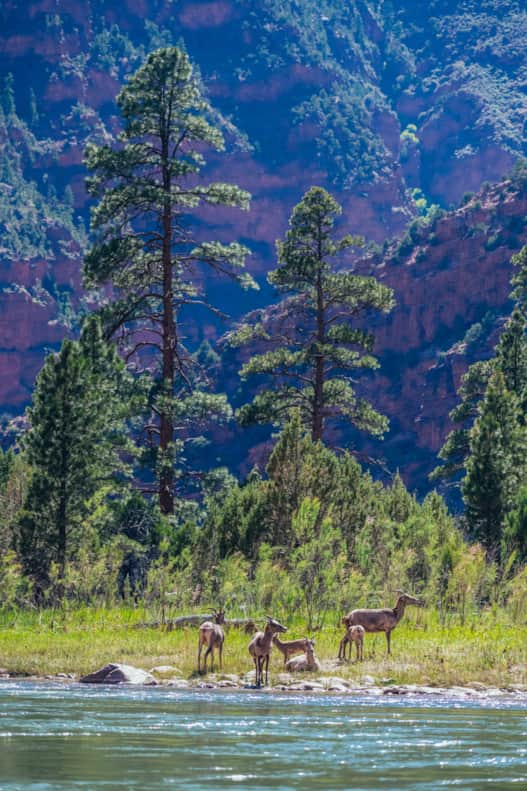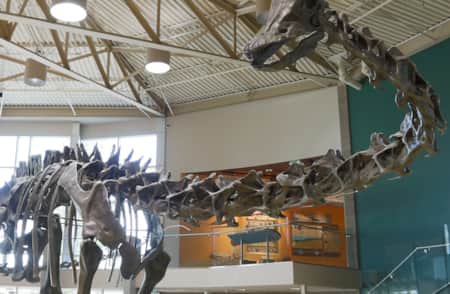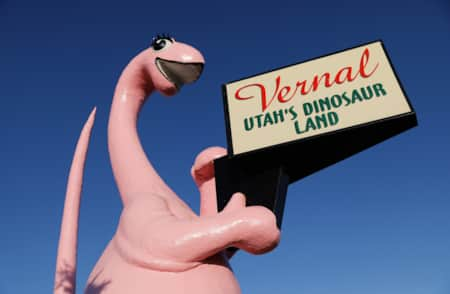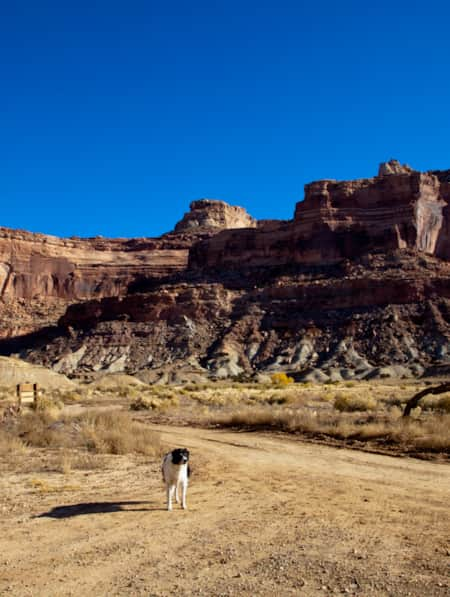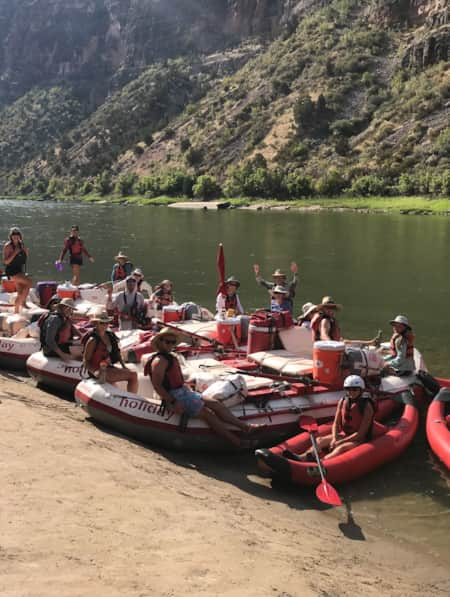Rafting in Dinosaur National Monument
Gaining a deeper appreciation on the river and a return trip to Utah’s Dinosaurland.
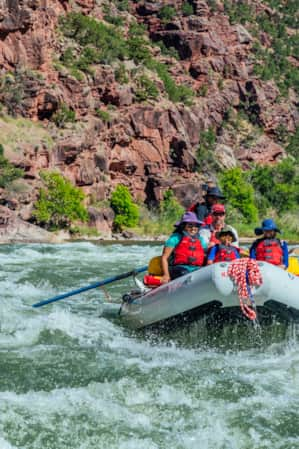
Our First Visit
Rafting on the Green River was our second trip to Dinosaur National Monument but a completely different way to experience the place. The first time we visited, in July, 2017, Dinosaur was a half-day stop on a three-week road trip through the national parks of the American West. Wanting to visit as many parks within that time frame, we took a slight detour and sandwiched a one-day DNM visit between Arches National Park near Moab, Utah, and Grand Teton National Park near Jackson, Wyoming.
During our 2017 visit, we visited the Dinosaur Quarry and the kids joined in a ranger presentation and my two younger kids participated in the junior ranger program. We had the opportunity to hold a real fossil. I had never held a real fossil before, and I was more excited at the opportunity than any of the kids. When the ranger placed the fossil in my hand, I still remember the surprise I felt at its weight. The fossil was much heavier than I imagined. Noah bought a dinosaur at the museum gift shop and promptly named him Sven. Sven was an active participant during the rest of our trip, accompanying us on all our hikes.
Afterward, we drove along Cub Creek Road, stopping along the way to look at petroglyphs, pictures carved out of the rocks hundreds of years ago. We also stopped and explored the Josie Bassett Morris ranch. Altogether, we spent less than five hours in the park before our overnight in nearby Vernal. It was a great overnight stop on a fast-paced road-trip itinerary, and I did not imagine I’d be back anytime soon.
The Return to Dinosaur
Now, we were back in the expansive monument and the quarry was nowhere in sight. We were down by the Green River on the Colorado side of the park. By the end of our trip, we’d be back in Utah, taking the only available route directly connecting the two sides of the park — the winding river.
We’d never rafted before and while videos of whitewater looked exciting, I wasn’t sure Noah could handle it. By July, we learned, the water levels are low enough that DRE takes kids as young as six years old. There is still plenty of whitewater, though.
“Best four days ever!” my seven-year-old son, Noah, exclaimed only 15 minutes into day one of a four-day river trip.
We were floating down the Green River. The cold water was mostly clear, though in the sunlight, the surface gave off a green hue. High, reddish-brown sandstone walls towered over us. The water was still relatively calm; the perfect opportunity to jump out of the boat, life jackets on and take our first swim.
Noah’s enthusiasm set the bar high, but I was excited as well. My three kids and I would be spending the next four days in Dinosaur National Monument rafting down the Green River. Vernal-based Dinosaur River Expeditions (DRE) would be taking us on the highly sought-after “Gates of Lodore” trip.
We live in Texas, by the Gulf Coast. A week out of the humidity and a chance to see high peaks and experience whitewater rapids was exciting enough that I didn’t need to sell the trip to the kids. My three kids, ranging from 7 to 16, packed up their own bags using DRE’s handy packing list and we boarded an early morning flight from Houston to Salt Lake City. By late afternoon, we were in Vernal at the DRE office’s sitting in on our river orientation.
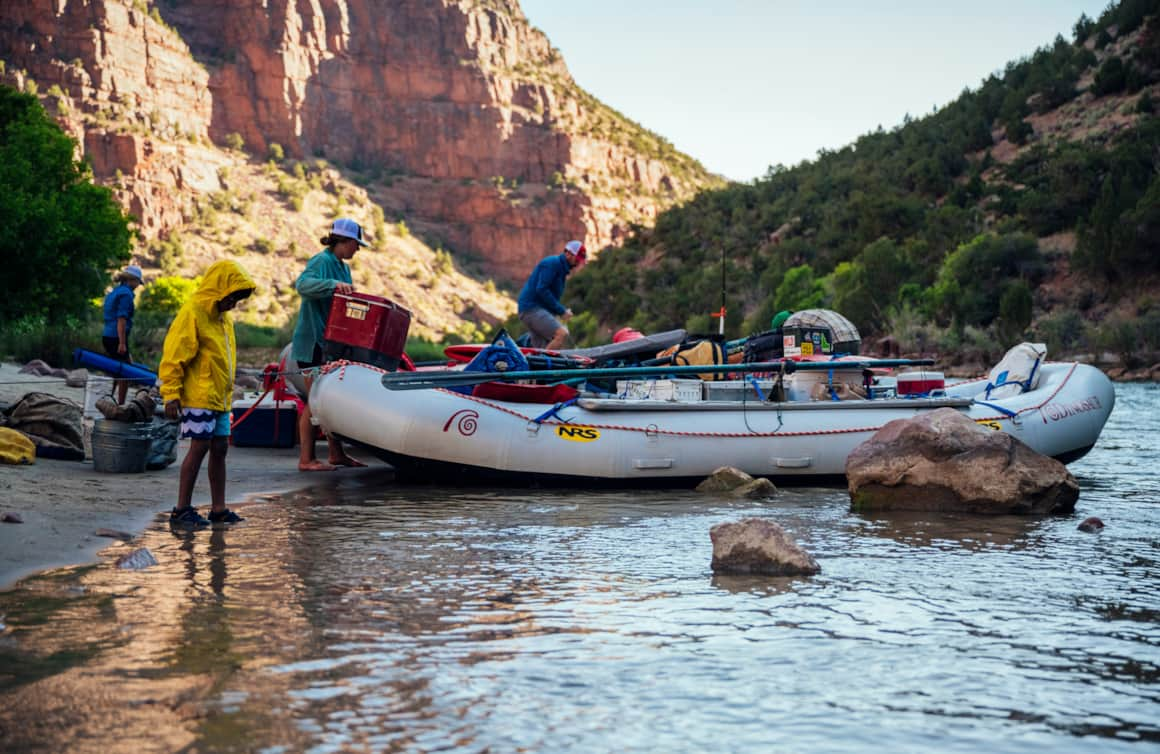
River trips can become logistical Olympics, so make your life a little easier by hiring a commercial outfitter.
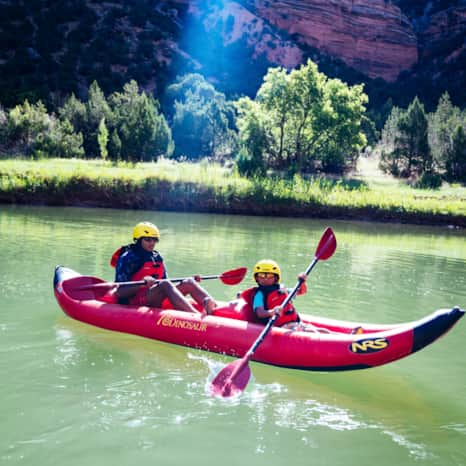
Fun for families, couples, and solo explorers, the West’s iconic Green River beckons to be discovered.

By July, the water levels of the Green River are usually low enough that some guide companies take kids as young as six years old.
"Our imaginations went wild as our guide, Callantine, pointed out certain rocks that looked like bears or monkeys. There was even a part of a canyon wall that looked like a pirate."
On the first day, Dinosaur River Expeditions picked us up from our hotel early that morning and dropped our gear and us off. During the two hour drive to the river, we got a chance to get to know our fellow travelers. As we approached the river, we could see glimpses of the canyon below us. While I couldn’t see the river from the road, I noticed small waterfalls along the way, building my sense of anticipation.
Owner, Tyler Callantine, and his guides met us at the river.
Once our gear was packed on the boats and safety rules explained, we were off. Noah and my 12-year-old daughter, Layla, rode in the raft with Tyler and myself, while my 16-year-old son, Eesa, kayaked in the “ducky” alongside us.
Spending four days along the river was a truly immersive experience and every day we discovered more of the parks secrets and enjoyed different types of water. There were calm moments where we had a chance to spot wildlife along the river. We saw bighorn sheep and deer. Above us, the kids spotted osprey, hawks and bald eagles flying over the canyon. Layla and Noah gave them all names.
Our imaginations went wild as our guide, Callantine, pointed out certain rocks that looked like bears or monkeys. There was even a part of a canyon wall that looked like a pirate.
While I wasn’t looking specifically for an educational trip, the river trip was an opportunity for the kids to expand their world. In addition to the raft, Callantine and his guides pointed out safe parts of the river for kayaking and paddling through the whitewater. The kids jumped off rocks into the water and swam and floated through the river’s currents.
Callantine would often pull the raft over to the shore to point out interesting spots along the canyon, including descriptions of those historic trips and the inscriptions they left behind. Noah, impressed by the information, later told me, “Early explorers were incredible! They went in whitewater in a wooden boat! They didn’t have all this!”
Callantine talked about his own connection to the river, including a great uncle, whose name is on one of the inscriptions on the canyon walls and different great uncle who was a renowned paleontologist in the area. In addition to his knowledge of the river, Callantine was able to interpret the different formations we saw, the geology, and wildlife.

As we floated down the river, beautiful red sandstone gave way to limestone and then sandstone again. With every turn of the river, wide breathtaking expanses opened up before our eyes.
Near Echo Park, Callantine rowed over to the canyon wall and asked the kids to yell the word “echo” on the count of three. A few seconds later, they could hear the words “echo” ringing back. A true echo, not something we had ever experienced before.
At times, shadows from the high canyon walls provided cool relief from the hot July sun. Other times, after being drenched by ice-cold water after going through the rapids, the warm sunlight felt good, helping us warm up and dry off.
I gained an appreciation for the river. Floating on the cold water kept us cool in the hot weather. We played in the water; we used it for washing. The river was a beacon not just for people, but for all types of life. In calm parts of the river, we would float by animals, like bighorn sheep drinking from the river. Another time, we saw a bird swoop down to catch a fish. One evening, as we were setting up camp, we saw a beaver swim up onto the shore.
Protecting the River
The guides took “Leave No Trace” principles seriously and made sure after stops along the river, we didn’t leave anything behind, including “micro-trash,” small pieces of rubbish that may seem inconsequential but harms wildlife. They taught us how to dispose of things correctly to keep the river clean.
It was evident that other travelers before us also followed these principles. Not only were we able to enjoy the clean water but our onshore experience was magical as well. We hiked to petroglyphs and Noah felt like an explorer as if he were discovering them for the first time.
In fact, Noah told me liked the hikes the best.
“I like the challenge,” he said. “I like that I accomplished something.”
On the pristine beaches, we would find animal tracks in the sand. One morning, we were examining what appeared to be a large insect track, when we saw some bird tracks. We followed them, gently impressing our own prints, and the kids guessed what type of animals could have made the various tracks.
"Not only were we able to enjoy the clean water but our onshore experience was magical as well. We hiked to petroglyphs and Noah felt like an explorer as if he were discovering them for the first time."
Adventure, Customized
Eesa loves the outdoors. At 16-years-old, he loved the opportunity and challenge to navigate the waters by himself. In fact, he spent almost the entire trip on the kayak on his own. The mama bear in me was concerned at first, but Callantine had him ride in the raft when there were too many rocks. While Eesa rode with us through Hell’s Half-Mile or Disaster Falls he enjoyed kayaking through some Class III rapids, such as Moonshine on day four.
Callantine would call out directions to Eesa so he could avoid hitting rocks as he paddled through rapids.
Layla enjoyed paddle boarding the most. At one point, as she paddled through some rapids, she got down on her knees to steady herself and prevented herself from falling off. She was so proud of herself. She was beaming and kept mentioning the incident.
She turns 13 at the end of summer. It’s a time in many girls’ lives where they struggle with self-esteem and image. These experiences will help her navigate teen years.
There’s no Internet in the backcountry, so Eesa and Layla left their phones back in Vernal. Layla had a Polaroid camera she used to take photos and Eesa had a digital camera. Before the trip, I bought Noah a one-use waterproof camera.
When not navigating the rapids, the kids would take pictures of the river, canyon vistas and wildlife. That was the extent of our access to technology, for four days. There was so much to discover outside, the phones seemed happily forgotten.
We ended our trip at the fossil quarry, where it began two years ago. It was like visiting an old friend. The kids reexamined the fossil displays. I watched other visitors, who were like us two years ago, coming to DNM for the first time. I wondered if any of them had experienced the river like we had or if like me two years ago, when the impression of the park was limited to a pit stop to look at dinosaur bones. After four days on the river, I realized that on our first visit we hadn’t even scratched the surface of what the monument had to offer. I now know its a place I can continue coming back to and have a different experience every time.
Inscriptions on the Wall
Throughout our four-day journey on the Green River, we stopped and examined inscriptions and pictographs on the canyon wall, connecting us with centuries of explorers and travelers on the Green River.
The inscriptions we saw dated as far back as 1838. Our guide, Tyler Callantine, told us stories behind the inscriptions, such as a fur trapper named Dennis Julien, who paddled upstream on the Green River. Another inscription belonged to Haldane “Buzz” Holstrom, the first person to run the river solo. Even Callantine’s own great uncle, Lee Kay, a wildlife surveyor for the Fish and Wildlife Department had an inscription along the river.
My seven-year-old, Noah, summed it up best.
“People did amazing things!” he said. “Buzz just had a wooden boat and he went down all that way by himself. The other guy went upstream. It’s amazing how much people do cool stuff on this river.”
We also stopped along the way and inspected pictographs left by early inhabitants in the area. There was one that looked like a man holding a bow standing in front of a group of mountain goats. The image is believed to be around 800 years ago.
The kids and I mulled over the possible meaning of the images we saw. We were careful not to touch any of the pictographs, but I found it incredible that these images survived outside in the elements for hundreds of years.
While we were all impressed by the actions of those who came before us, we were also grateful that these places have been preserved for us to enjoy.

Plan for a rare opportunity to unplug from the pace of everyday life and to receive one of the most memorable experiences of your lifetime.
Photo: Jeremiah Watt
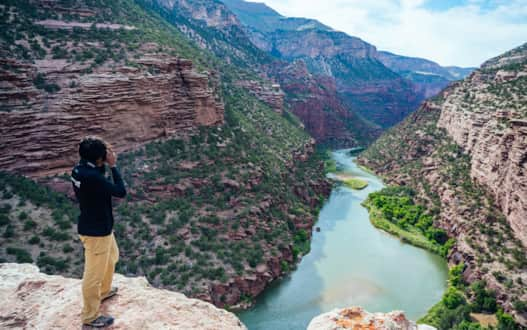
Take advantage of the many hiking opportunities to view native american rock art, skiffs abandoned by early river-explorers, abandoned ranches, and even a prohibition-era whiskey outpost.

Petroglyphs, wildlife, scenery, sunsets, soaring cliffs — you name it, and Green River provides.
Photo: Jeremiah Watt
What's Nearby
-

Ashley National Forest
Elevations in the Ashley National Forest range from 6,000 feet to over 13,500 feet. The crown jewel of this forest is Flaming Gorge National Recreation Area.
-

Dinosaur National Monument
Northeastern Utah’s dinosaur legacy comes to life at Dinosaur National Monument, where geological and climatic forces have tilted, warped, and eroded the earth’s crust to reveal a treasure trove of fossils.
-

Flaming Gorge National Recreation Area
With more than 200,000 acres of land and water, Flaming Gorge is a scenic playground for boating, waterskiing, windsurfing, camping and backpacking in addition to some of the best fishing in the west.
-

Uinta Basin
The Uinta Basin covers nearly all of northeastern Utah. Rolling sagebrush planes are surrounded by lofty mountains in every direction. The culture, history and natural splendor of Utah’s northeastern corner makes it a pleasure to visit any time of year.
-

Utah Field House of Natural History State Park Museum
Explore Utah's incredible geological history at the Utah Field House of Natural History State Park Museum. See dinosaurs, interactive exhibits and more!
-

Vernal
Enjoy a family adventure in Vernal, UT, with a list of hotels and fun things to do with kids in the area.
